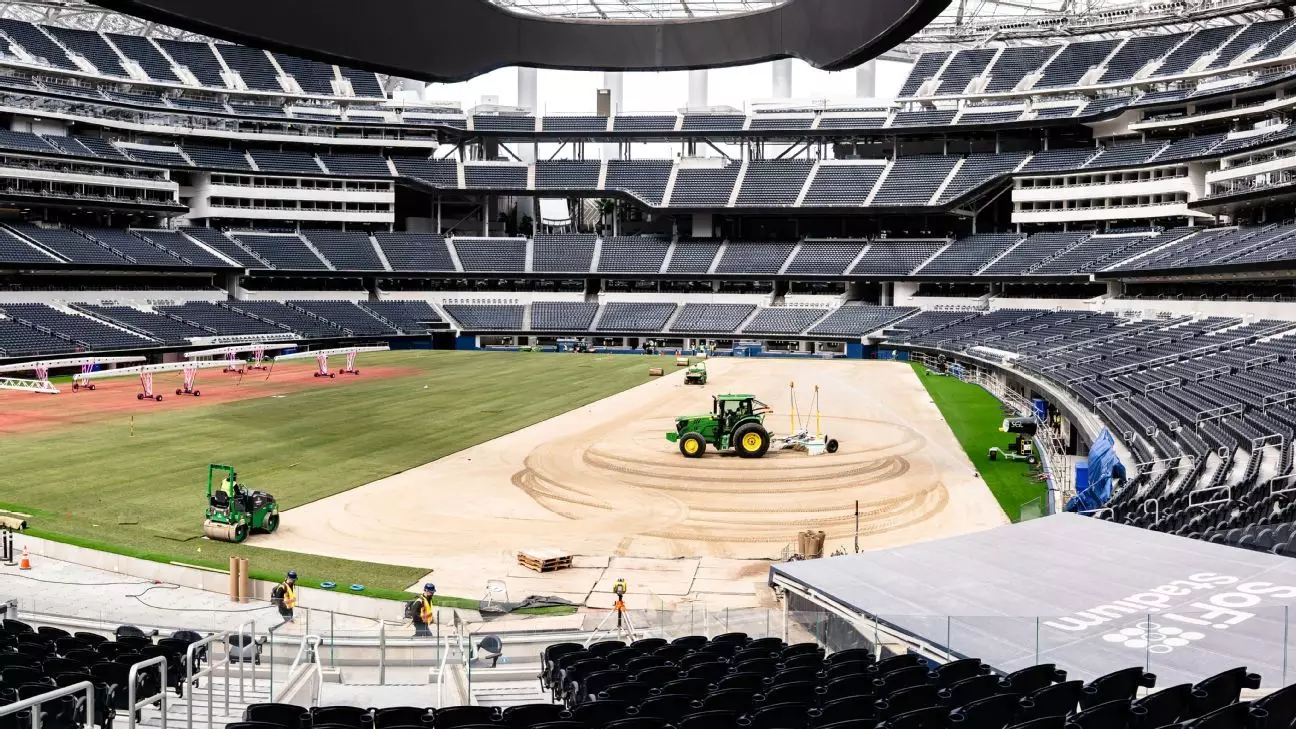In the world of sports, where the quality of the playing surface is paramount to athlete performance and spectator enjoyment, innovation has taken a bold leap forward at SoFi Stadium in Los Angeles. With the FIFA World Cup 2026 on the horizon, SoFi is set to deploy a cutting-edge hybrid grass system during the Concacaf Nations League semi-finals. This initiative marks a significant experiment in enhancing field quality and preparing for the grand stage of world soccer.
SoFi Stadium’s senior vice president of facilities and campus operations, Otto Benedict, described this project as a “great opportunity” to refine the stadium’s offerings prior to the global event. He stated that the introduction of the hybrid grass aims not only to improve the playing surface but also to learn from this deployment to ensure that the World Cup experience is unparalleled. The current transition to a hybrid grass system—combining artificial turf with natural grass—signals a notable turnaround from the criticisms faced during previous tournaments where players often voiced concerns about field quality.
The Hybrid Grass System: A Closer Look
What’s noteworthy about SoFi’s hybrid grass is its innovative construction, which features state-of-the-art technology not seen in many other venues. An essential component of this system is the “permavoid,” a network of black plastic crates beneath the grass that allows for improved aeration and drainage. This unique setup is designed to keep the root zone healthy, ensuring that grass grows optimally, even in challenging conditions. As Benedict explains, the system can pump air into the roots, which brings in necessary oxygen and dries out excess moisture, allowing the grass to thrive and remain intact.
The amalgamation of both artificial and natural elements creates a robust field. Benedict suggests that this makes the grass less prone to wear and tear compared to traditional fully grass fields. Notably, this solid foundation could mitigate concerns regarding field degradation that often arises in multi-sport venues. As highlighted by former U.S. men’s national team player Cobi Jones, the aesthetic authenticity of the hybrid grass is impressive, appearing seamlessly like natural grass without visible lines of division.
Seeking Perfection Under Unique Conditions
One of the major challenges facing SoFi Stadium’s hybrid grass initiative is the absence of natural sunlight due to the stadium’s covered structure. To overcome this limitation, the maintenance team employs LED grow lights, which are moved across the field continually. This approach ensures that the grass receives adequate light to facilitate photosynthesis, which is vital for its overall health and longevity. In addition, the stadium management is preparing an alternative growing area with another 10,000 square feet of hybrid grass to replace any worn sections on the main field, reflecting a comprehensive strategy to maintain quality during high-stakes matches.
The maintenance required for this hybrid system is significantly greater than that for conventional artificial surfaces—double the number of staff is needed for its upkeep, ensuring the highest standards for both aesthetics and functionality. This commitment to quality is a strong indicator of SoFi Stadium’s dedication to providing an exceptional sports experience.
Lessons from Past Criticisms and Future Aspirations
The implementation of the hybrid grass technology also serves as a response to the considerable backlash regarding field quality in recent years, particularly during the 2021 Copa América. Players like Weston McKennie lamented the poor conditions of previous playing fields, which often led to disrupted game flow and increased injury risk. This sentiment emphasizes the critical need for stadiums to invest in better technologies before hosting significant events, as players’ comfort and performance are directly linked to the quality of the pitch.
As SoFi Stadium gears up for the Nations League matches and ultimately the World Cup, it stands at the forefront of a shift in field management that could redefine best practices in stadium operations. Their proactive measures represent a paradigm shift that not only prioritizes the needs of athletes but also aligns perfectly with the demands of modern sports fandom. The stadium is not merely preparing for a series of matches; it is setting a new standard for how athletes interact with their environments by innovatively blending natural and synthetic materials.
In essence, SoFi Stadium’s hybrid grass field technology may not just enhance the playing surface at this upcoming tournament; it could serve as a potential model for future developments across sporting venues around the world. As the landscape of sports evolves, SoFi’s approach signifies a commitment to excellence that may redefine expectations for years to come.

